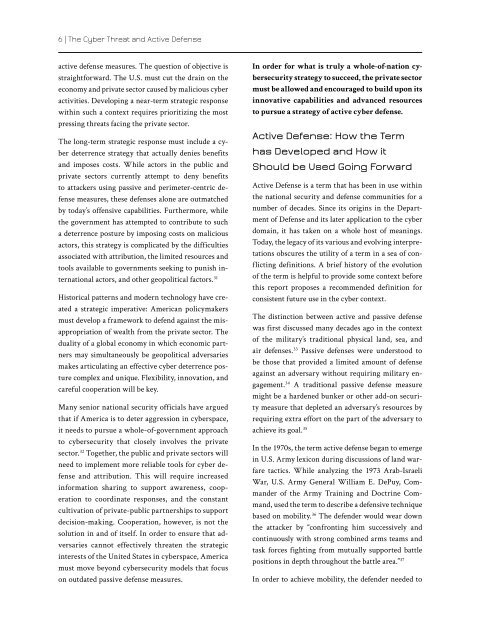Into the Gray Zone
2f1BbTW
2f1BbTW
Create successful ePaper yourself
Turn your PDF publications into a flip-book with our unique Google optimized e-Paper software.
6 | The Cyber Threat and Active Defense<br />
active defense measures. The question of objective is<br />
straightforward. The U.S. must cut <strong>the</strong> drain on <strong>the</strong><br />
economy and private sector caused by malicious cyber<br />
activities. Developing a near-term strategic response<br />
within such a context requires prioritizing <strong>the</strong> most<br />
pressing threats facing <strong>the</strong> private sector.<br />
The long-term strategic response must include a cyber<br />
deterrence strategy that actually denies benefits<br />
and imposes costs. While actors in <strong>the</strong> public and<br />
private sectors currently attempt to deny benefits<br />
to attackers using passive and perimeter-centric defense<br />
measures, <strong>the</strong>se defenses alone are outmatched<br />
by today’s offensive capabilities. Fur<strong>the</strong>rmore, while<br />
<strong>the</strong> government has attempted to contribute to such<br />
a deterrence posture by imposing costs on malicious<br />
actors, this strategy is complicated by <strong>the</strong> difficulties<br />
associated with attribution, <strong>the</strong> limited resources and<br />
tools available to governments seeking to punish international<br />
actors, and o<strong>the</strong>r geopolitical factors. 31<br />
Historical patterns and modern technology have created<br />
a strategic imperative: American policymakers<br />
must develop a framework to defend against <strong>the</strong> misappropriation<br />
of wealth from <strong>the</strong> private sector. The<br />
duality of a global economy in which economic partners<br />
may simultaneously be geopolitical adversaries<br />
makes articulating an effective cyber deterrence posture<br />
complex and unique. Flexibility, innovation, and<br />
careful cooperation will be key.<br />
Many senior national security officials have argued<br />
that if America is to deter aggression in cyberspace,<br />
it needs to pursue a whole-of-government approach<br />
to cybersecurity that closely involves <strong>the</strong> private<br />
sector. 32 Toge<strong>the</strong>r, <strong>the</strong> public and private sectors will<br />
need to implement more reliable tools for cyber defense<br />
and attribution. This will require increased<br />
information sharing to support awareness, cooperation<br />
to coordinate responses, and <strong>the</strong> constant<br />
cultivation of private-public partnerships to support<br />
decision-making. Cooperation, however, is not <strong>the</strong><br />
solution in and of itself. In order to ensure that adversaries<br />
cannot effectively threaten <strong>the</strong> strategic<br />
interests of <strong>the</strong> United States in cyberspace, America<br />
must move beyond cybersecurity models that focus<br />
on outdated passive defense measures.<br />
In order for what is truly a whole-of-nation cybersecurity<br />
strategy to succeed, <strong>the</strong> private sector<br />
must be allowed and encouraged to build upon its<br />
innovative capabilities and advanced resources<br />
to pursue a strategy of active cyber defense.<br />
Active Defense: How <strong>the</strong> Term<br />
has Developed and How it<br />
Should be Used Going Forward<br />
Active Defense is a term that has been in use within<br />
<strong>the</strong> national security and defense communities for a<br />
number of decades. Since its origins in <strong>the</strong> Department<br />
of Defense and its later application to <strong>the</strong> cyber<br />
domain, it has taken on a whole host of meanings.<br />
Today, <strong>the</strong> legacy of its various and evolving interpretations<br />
obscures <strong>the</strong> utility of a term in a sea of conflicting<br />
definitions. A brief history of <strong>the</strong> evolution<br />
of <strong>the</strong> term is helpful to provide some context before<br />
this report proposes a recommended definition for<br />
consistent future use in <strong>the</strong> cyber context.<br />
The distinction between active and passive defense<br />
was first discussed many decades ago in <strong>the</strong> context<br />
of <strong>the</strong> military’s traditional physical land, sea, and<br />
air defenses. 33 Passive defenses were understood to<br />
be those that provided a limited amount of defense<br />
against an adversary without requiring military engagement.<br />
34 A traditional passive defense measure<br />
might be a hardened bunker or o<strong>the</strong>r add-on security<br />
measure that depleted an adversary’s resources by<br />
requiring extra effort on <strong>the</strong> part of <strong>the</strong> adversary to<br />
achieve its goal. 35<br />
In <strong>the</strong> 1970s, <strong>the</strong> term active defense began to emerge<br />
in U.S. Army lexicon during discussions of land warfare<br />
tactics. While analyzing <strong>the</strong> 1973 Arab-Israeli<br />
War, U.S. Army General William E. DePuy, Commander<br />
of <strong>the</strong> Army Training and Doctrine Command,<br />
used <strong>the</strong> term to describe a defensive technique<br />
based on mobility. 36 The defender would wear down<br />
<strong>the</strong> attacker by “confronting him successively and<br />
continuously with strong combined arms teams and<br />
task forces fighting from mutually supported battle<br />
positions in depth throughout <strong>the</strong> battle area.” 37<br />
In order to achieve mobility, <strong>the</strong> defender needed to


